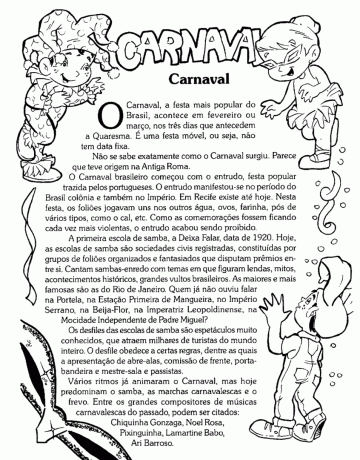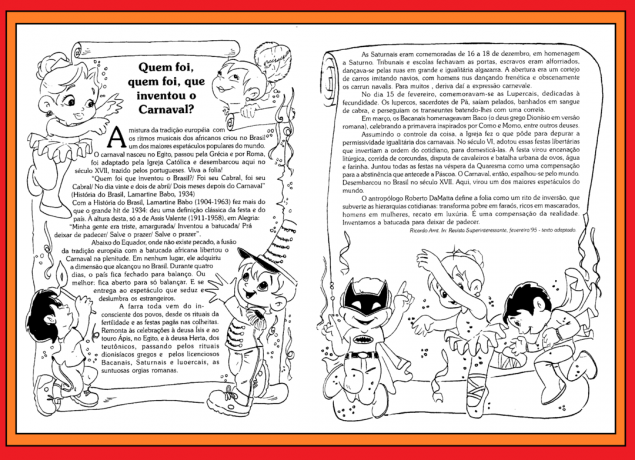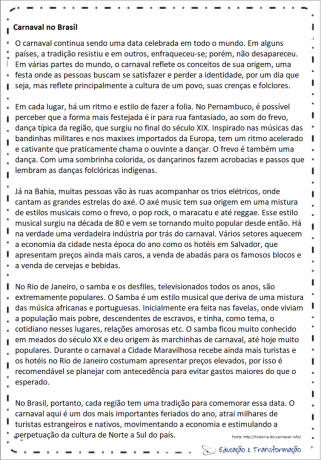
We selected in this post some texts on the origin of Carnival, to copy on print.
Carnival is a festival that originated in Greece in the mid 600s to 520s BC. Ç. Through this festival, the Greeks performed their cults in thanks to the gods for the fertility of the soil and agricultural production.
See too:
Years later and with the advance of Christianity, the Catholic Church began to fight all pagan festivals and manifestations, and with the impossibility of exterminating its practice, it ended up incorporating them into its beliefs such as Christmas and All Day Saints.
Index


Also check: Texts and activities about carnival
Carnival, the most popular festival in Brazil, takes place in February or March, in the three days before Lent. And a mobile party, that is, it has no fixed date.
It is not known exactly how Carnival came about. It seems to have originated in Ancient Rome.
The Brazilian Carnival began with the Shrovetide, a popular festival brought by the Portuguese. Shrovetide manifested itself in the period of colonial Brazil and also in the Empire. In Recife it still exists today. At this party, the revelers threw water, eggs, flour, powders of various kinds, such as lime, etc., at each other. As the celebrations became more and more violent, Shrovetide ended up being banned.
The first samba school, Let Falar, dates back to 1920. Today, samba schools are registered civil societies, made up of groups of organized and costumed revelers who compete for prizes among themselves. They sing samba-enredo with themes featuring legends, myths, historical events, great Brazilian figures. The biggest and most famous are those in Rio de Janeiro. Who has not heard of Portela, Estação Primeira de Mangueira, Império Serrano, Beija-Flor, Imperatriz Leopoldinense, Mocidade Independente de Padre Miguel?
The samba school parades are well-known shows that attract thousands of tourists from all over the world. The parade obeys certain rules, among which the presentation of open wings, front commission, flag bearer and master of the hall and dancers.
Several rhythms have already animated Carnival, but today samba, carnival marches and frevo predominate. Among the great composers of carnival music from the past, we can mention: Chiquinha Gonzaga. Noel Rosa, Pixinguinha, Lamartine Babo, Ari Barroso.
The mixture of European tradition with the musical rhythms of Africans created in Brazil one of the greatest popular shows in the world. Carnival was born in Egypt, passed through Greece and Rome, was adapted by the Catholic Church and landed here in the 17th century, brought by the Portuguese. Live the fun!
“Who invented Brazil?/ It was Mr. Cabral, it was Mr. Cabral/ On the 22nd of April/ Two months after Carnival” (História do Brasil, Lamartine Babo, 1934)
With the History of Brazil, Lamartine Babo (1904-1963) did more than the great 1934 hit: he gave a classic definition of the party and the country. The height of this one, only that of Assis Valente (1911-1958), in Alegria: “My people were sad, bitter / He invented drums / To stop suffering / Save the pleasure / Save the pleasure”.
Below the Equator, where there is no sin, the fusion of European tradition with African drumming liberated Carnival to its fullest. Nowhere did it acquire the dimension it achieved in Brazil. For four days, the country is closed for balance. Or rather: it stays open to just swing. And give in to the spectacle that seduces and dazzles foreigners.
The whole spree comes from people's unconscious, from fertility rituals and pagan harvest festivals.
It dates back to the celebrations of the goddess Isis and the bull Apis, in Egypt, and the goddess Herta, of the Teutonic, passing by by the Greek Dionysian rituals and by the licentious Bacchanals, Saturnales and Luoercais, the sumptuous orgies Romans.
The Saturnais were celebrated from December 16th to 18th, in honor of Saturn. Courts and schools closed their doors, slaves were freed, the streets were danced in a great and equal din. The opening was a procession of cars imitating ships, with naked men dancing frantically and obscenely the carrun navalis. For many, the expression meat is derived from this.
On February 15th, the Lupercais, dedicated to fertility, were celebrated. The lupercs, priests of Pan, came out naked, bathed in goat's blood, and chased passersby hitting them with a leash.
In March, the Bacchanals honored Bacchus (the Greek god Dionysus in the Roman version), celebrating springtime inspired by Como and Momo, among other gods.
Taking control of the thing, the Church did what it could to purify the egalitarian permissiveness of the carnivals. In the sixth century, it adopted these libertarian festivals that inverted the order of everyday life, in order to domesticate them. The party became a liturgical reenactment, a humpback race, a knight dispute and an urban battle of eggs, water and flour. He put together all the parties on the eve of Lent as a compensation for the abstinence that precedes Easter. Carnival, then, spread around the world. Landed in Brazil in the 17th century. Here, it became one of the greatest shows in the world.
Anthropologist Roberto DaMatta defines revelry as a rite of inversion, which subverts everyday hierarchies: transforming the poor into pharaohs, rich into masked men, men into women, modesty into luxury. And a compensation for reality. We invented drumming to stop suffering.
Ricardo Arnt. In: Revista Superinteressante, February/95 – adapted text.
Information text to print:

Informative text about Carnival in Brazil to print.

See also: How did Carnival come about?
Carnival arrived in Brazil in the 13th century, when the Portuguese brought the game of Shrovetide, typical of the region of Azores and Cape Verde, which consisted of a game in which people soiled each other with paint, flour, eggs and also threw Water.
In the 19th century, Parisian balls were promoted, in which guests were required to wear masks. Interest in this type of party grew because Shrovetide caused a lot of confusion as it was a practice that called for violence. At the balls, which took place indoors, the public was made up of guests who were willing to dress up and listen to music. An important figure from this period is Chiquinha Gonzaga who composed carnival music and belonged to this bourgeois class group that frequented the balls.
In Rio de Janeiro, in the 20th century, the first samba schools emerged. In the late 1920s, the parades were very popular with the population and became a popular form of celebration of the still very strong carnival, both in Rio and São Paulo. In the Northeast of the country, the most popular way to spend carnival is to go to the streets, keeping a little of the tradition brought by the Portuguese. In Bahia, more specifically, the street carnival custom was maintained, but the electric trios were strengthened after the 1980s.
Subscribe to our email list and receive interesting information and updates in your email inbox
Thanks for signing up.


